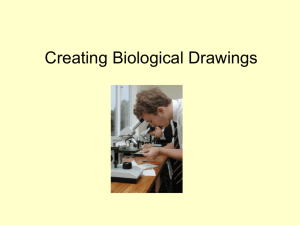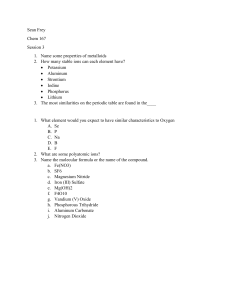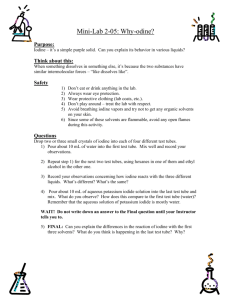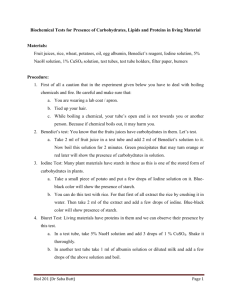File
advertisement
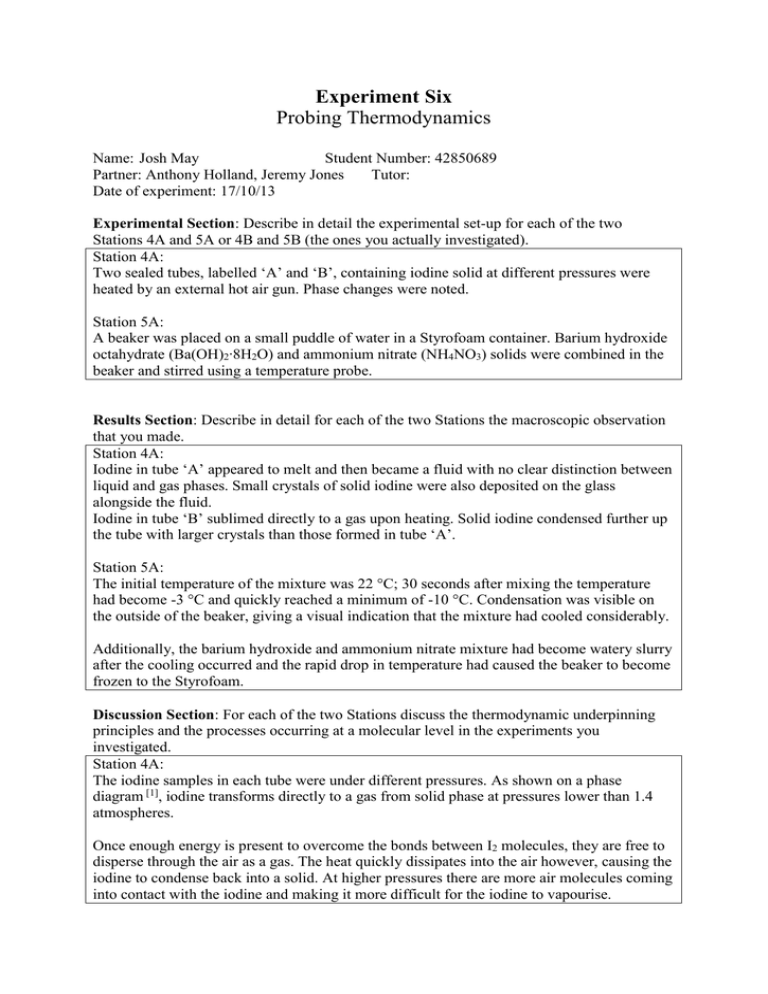
Experiment Six Probing Thermodynamics Name: Josh May Student Number: 42850689 Partner: Anthony Holland, Jeremy Jones Tutor: Date of experiment: 17/10/13 Experimental Section: Describe in detail the experimental set-up for each of the two Stations 4A and 5A or 4B and 5B (the ones you actually investigated). Station 4A: Two sealed tubes, labelled ‘A’ and ‘B’, containing iodine solid at different pressures were heated by an external hot air gun. Phase changes were noted. Station 5A: A beaker was placed on a small puddle of water in a Styrofoam container. Barium hydroxide octahydrate (Ba(OH)2∙8H2O) and ammonium nitrate (NH4NO3) solids were combined in the beaker and stirred using a temperature probe. Results Section: Describe in detail for each of the two Stations the macroscopic observation that you made. Station 4A: Iodine in tube ‘A’ appeared to melt and then became a fluid with no clear distinction between liquid and gas phases. Small crystals of solid iodine were also deposited on the glass alongside the fluid. Iodine in tube ‘B’ sublimed directly to a gas upon heating. Solid iodine condensed further up the tube with larger crystals than those formed in tube ‘A’. Station 5A: The initial temperature of the mixture was 22 °C; 30 seconds after mixing the temperature had become -3 °C and quickly reached a minimum of -10 °C. Condensation was visible on the outside of the beaker, giving a visual indication that the mixture had cooled considerably. Additionally, the barium hydroxide and ammonium nitrate mixture had become watery slurry after the cooling occurred and the rapid drop in temperature had caused the beaker to become frozen to the Styrofoam. Discussion Section: For each of the two Stations discuss the thermodynamic underpinning principles and the processes occurring at a molecular level in the experiments you investigated. Station 4A: The iodine samples in each tube were under different pressures. As shown on a phase diagram [1], iodine transforms directly to a gas from solid phase at pressures lower than 1.4 atmospheres. Once enough energy is present to overcome the bonds between I2 molecules, they are free to disperse through the air as a gas. The heat quickly dissipates into the air however, causing the iodine to condense back into a solid. At higher pressures there are more air molecules coming into contact with the iodine and making it more difficult for the iodine to vapourise. The iodine in tube ‘B’ was likely at atmospheric pressure so it sublimed rather than melted. The iodine in tube ‘A’, however, seemed to be at its triple point. The triple point is where the conditions for solid, liquid and gas meet, resulting in all three phases being present simultaneously. Station 5A: Barium hydroxide and ammonium nitrate react in the solid phase to form ammonia and barium nitrate according to the equation Ba(OH)2∙8H2O(s) + 2NH4NO3(s) Ba(NO3)2(s) + 2NH3(aq) + 10H2O(l) [2]. The temperature of the mixture dropped sharply, indicating that heat entered the system from the surroundings. This means that the change in enthalpy of the reaction is positive; this disfavours spontaneity. The reaction occurs spontaneously however, which can be explained by the large increase in entropy generated when three molecules of two solids form a total thirteen molecules of solid, liquid and solution. The energy required to form these bonds in greater than the energy released from breaking the bonds of the reactants, thus the reaction draws heat from its surroundings to fuel itself. Conclusion Section: In a short paragraph summarise the discussion. Iodine undergoes different phase changes depending on the pressure; liquid only exists above a certain pressure for all substances. Reactions with a positive enthalpy and entropy can progress spontaneously to draw heat from their surroundings and rapidly cool their immediate vicinity. References: The relevant literature used throughout the report must be appropriately referenced. In text in the sections above indicate a reference by superscript number. 1) Weiner, J A 2013, Phase diagram of iodine, viewed 24 October 2013, <https://sp.eths.k12.il.us/weinerj/2chemphys/Lists/UNIT%208%20Liquids%20%20Solids%2 0continued/Attachments/24/phase%20diagram%20of%20iodine.pdf> 2) University of Minnesota 2012, Endothermic and Exothermic Reactions, viewed 24 October 2013, <http://www.chem.umn.edu/outreach/EndoExo.html>
